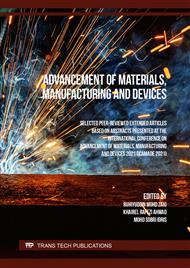[1]
Y. C. Hsu, C. Y. Ting, L. S. Hsu, J. Y. Lin, and C. C. P. Chen, A transient enhancement DC-DC buck converter with dual operating modes control technique, IEEE Transactions on Circuits and Systems II: Express Briefs. 66 (2019) 1376–1380.
DOI: 10.1109/tcsii.2018.2883889
Google Scholar
[2]
S. A. Lopa, S. Hossain, M. K. Hasan, and T. K. Chakraborty, Design and Simulation of DC-DC Converters, International Research Journal of Engineering and Technology, (2016) 2395–56.
Google Scholar
[3]
Y. Lang, X. Ge, R. Gu, and Y. Zhang, The closed-loop design for buck chopper circuit, 2017 International Conference on Circuits, Devices and Systems, ICCDS 2017, (2017) 38–43.
DOI: 10.1109/iccds.2017.8120447
Google Scholar
[4]
R. Modak and M. S. Baghini, A generic analytical model of switching characteristics for efficiency-oriented design and optimization of cmos integrated buck converters, Proceedings of the IEEE International Conference on Industrial Technology, (2009) 1–6.
DOI: 10.1109/icit.2009.4939579
Google Scholar
[5]
D. Kovác et al., Circuit elements influence on optimal number of phases of DC/DC buck converter, Electronics Letters, 54, (2018) 435–437.
DOI: 10.1049/el.2018.0043
Google Scholar
[6]
A. Mohammad, M. S. Rahaman, O. Ahmed, A. I. Aziz, T. U. Muntakim, and M. S. Shaon, Realization of existence of two buck chopper circuits in a single-phase switch controlled full wave rectifier, 2nd International Conference on Electrical Engineering and Information and Communication Technology, iCEEiCT, 1, (2015) 21–23.
DOI: 10.1109/iceeict.2015.7307357
Google Scholar
[7]
M. Veerachary and V. Khubchandani, Analysis, Design, and Control of Switching Capacitor Based Buck-Boost Converter, IEEE Transactions on Industry Applications, 55, (2019) 2845–2857.
DOI: 10.1109/tia.2018.2889848
Google Scholar
[8]
M. Beres, D. Schweiner, I. Kovacova, and A. Kalinov, Current ripple comparison of multi and single-phase Buck-boost converters, Proceedings of the International Conference on Modern Electrical and Energy Systems, (2018) 260–263.
DOI: 10.1109/mees.2017.8248905
Google Scholar
[9]
S. Page, A. Wajda, and H. Hess, High voltage tolerant stacked MOSFET in a Buck converter application, 2012 IEEE Workshop on Microelectronics and Electron Devices, (2012) 37–40.
DOI: 10.1109/wmed.2012.6202612
Google Scholar
[10]
Nirmal, P. K. Jain, and A. Kumar, Interleaved DC to DC buck converter for low power application, 2015 International Conference on Energy, Power and Environment: Towards Sustainable Growth, ICEPE 2015, (2016) 0–4.
DOI: 10.1109/epetsg.2015.7510110
Google Scholar
[11]
M. S. B. Ranjana, S. M. Badave, P. Kiranmaroti, S. M. Mule, and R. M. Kulkarni, DC-DC current buck converter through duality approach and its DC transformer modelling for current based loads, Proceedings of IEEE International Conference on Circuit, Power and Computing Technologies, ICCPCT 2016, (2016).
DOI: 10.1109/iccpct.2016.7530111
Google Scholar
[12]
U. A. Khan, A. A. Khan, H. Cha, H. G. Kim, J. Kim, and J. W. Baek, Dual-Buck AC-AC Converter with Inverting and Non-Inverting Operations, IEEE Transactions on Power Electronics, 33, (2018) 9432–9443.
DOI: 10.1109/tpel.2018.2799490
Google Scholar
[13]
T. K. Nizami and C. Mahanta, "An intelligent adaptive control of DC-DC buck converters, Journal of the Franklin Institute, 353, (2016) 2588–2613.
DOI: 10.1016/j.jfranklin.2016.04.008
Google Scholar
[14]
G. Vijay and D. K. Palwalia, A Novel Analysis and Modeling of Boost and Buck Converter, 6, (2017), 239–243.
Google Scholar
[15]
M. Hajimoradi and H. Mokhtari, High-efficiency low-cost AC/AC buck converter with stability analysis, IET Power Electronics, 10, (2017), 802–807.
DOI: 10.1049/iet-pel.2015.0713
Google Scholar
[16]
X. Y. Chen et al., Design and digital control of a cryogenic boost-buck chopper, 2015 IEEE International Conference on Applied Superconductivity and Electromagnetic Devices, ASEMD 2015 - Proceedings, (2016) 15–16.
DOI: 10.1109/asemd.2015.7453444
Google Scholar
[17]
A. A. A. Ismail and A. Elnady, Advanced Drive System for DC Motor Using Multilevel DC/DC Buck Converter Circuit, IEEE Access, 7, (2019) 54167–54178.
DOI: 10.1109/access.2019.2912315
Google Scholar
[18]
M. Okuda and T. Takeshita, Bidirectional Buck AC / DC Converters for Compact Size and High Efficiency PWM Strategy of AC / DC Converter, 1–10.
DOI: 10.23919/epe17ecceeurope.2017.8099123
Google Scholar



